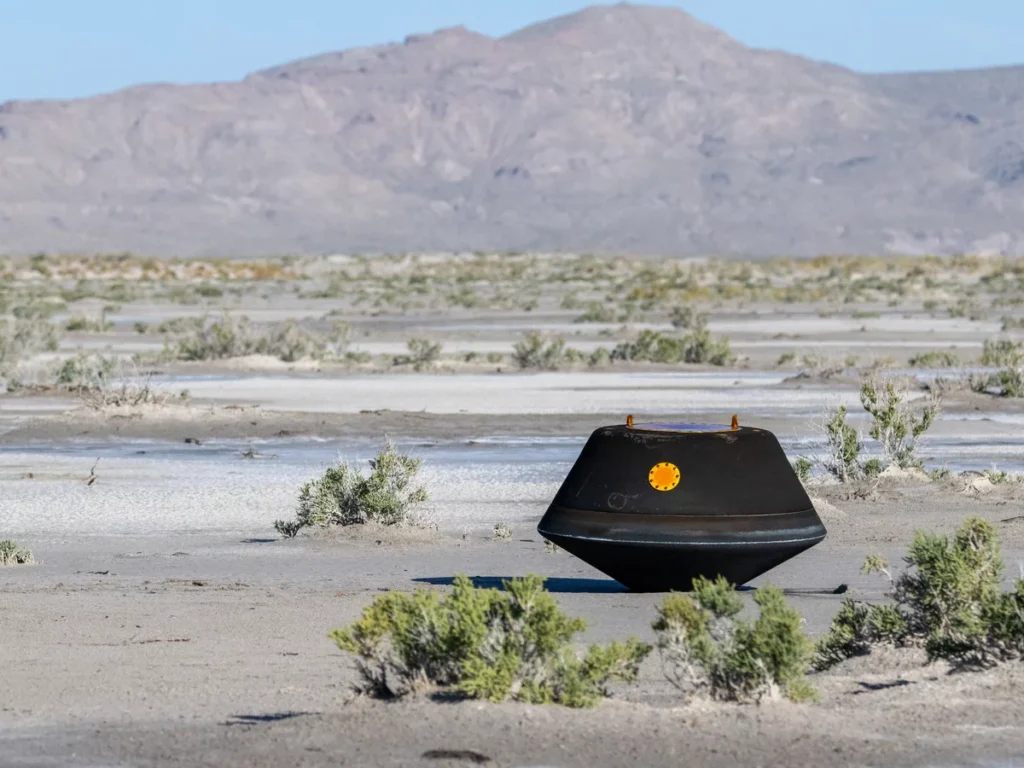NASA Capsule Safely Returns with Largest Asteroid Sample
After a long seven-year journey through space, a NASA capsule safely landed in the Utah desert, bringing back the biggest chunks of asteroid ever gathered by people. Scientists are thrilled to study these samples, hoping they’ll reveal more about how our solar system came to be and how Earth became a place where life could thrive.

After an extraordinary seven-year journey through space, a NASA capsule successfully returned to Earth, touching down in the deserts of Utah, USA. Th
is capsule carried the largest samples of an asteroid ever collected by humans. Scientists are eagerly anticipating what these samples may reveal, as they hold the potential to deepen our understanding of how our solar system formed and how Earth became a hospitable planet.
The Osiris-Rex probe’s dramatic re-entry into Earth’s atmosphere captured the world’s attention due to the inherent risks involved. Remarkably, the capsule achieved a soft landing at a military test range in northwestern Utah.
The Osiris-Rex mission began in 2016, culminating in the spacecraft’s landing on the asteroid “Bennu” in 2020. During this mission, it managed to collect approximately nine ounces (250 grams) of dust from the asteroid’s rocky surface, though scientists had hoped for a larger haul.
Japan is the only other country to have successfully brought back asteroid samples, albeit only a teaspoon’s worth.
Despite its small quantity, NASA believes that even this modest amount of asteroid dust will significantly enhance our understanding of potentially Earth-threatening asteroid types and shed light on the early history of our solar system. NASA scientist Amy Simon described this sample return as “historic” and comparable in significance to the Apollo moon rocks brought back to Earth.
The Osiris-Rex probe released the capsule from a height of more than 67,000 miles (108,000 kilometers) roughly four hours before its scheduled landing.
Over the course of its mission, the spacecraft covered a staggering 4 billion miles (6.2 billion kilometers). The most intense part of its return occurred in the final 13 minutes, during which the capsule hurtled through the atmosphere at speeds exceeding 27,000 miles per hour, subjected to temperatures reaching up to 5,000 Fahrenheit (2,760 Celsius). Army sensors closely monitored its rapid descent, and parachutes successfully slowed the capsule to about 11 mph just before it gently touched down in the desert.
Upon arrival, the precious sample will be transported by helicopter to a “clean room” at the Utah test range for initial examination. It will then make its way to NASA’s Johnson Space Center in Houston, where it will be divided into smaller specimens for distribution to approximately 200 scientists in 60 laboratories worldwide.
NASA plans to unveil its initial findings at a press conference scheduled for October 11.
Asteroids, composed of materials dating back some 4.5 billion years, offer insights into the formation and evolution of our solar system. They hold a cosmic origin story and have significantly impacted Earth’s history, potentially delivering essential materials such as water and organic substances through impacts in the distant past.
Bennu, the asteroid of interest in this mission, is approximately 500 meters (1,640 feet) in diameter and rich in carbon, potentially housing water molecules within its minerals. Its peculiar characteristics, including lower-than-expected density, became apparent during the probe’s contact with its surface in 2020. Understanding the composition of asteroids like Bennu holds vital implications for the future.
To read more on Science News Click Here